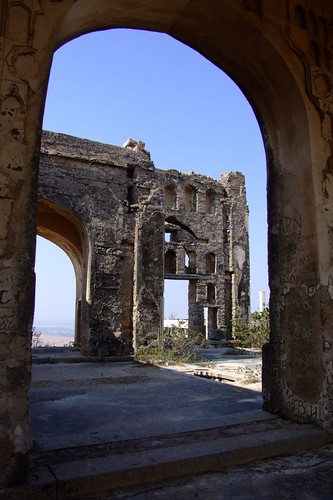
After reaching the station, they pulled up an auto rickshaw, which ferried the merry bunch to the fort steps, barely 2 kms away, for 5 bucks a head.
The fort was built by king Tribhuvana of the Chalukya dynasty in the 11th Century AD. The stone wall surrounding the fort still stands today, along with stone steps and ruined archways coiling to the top of the hill.

The area was known as Bhuvan Giri, later shortened to the more familiar Bhongir. An interesting feature of the fort is the series of reservoirs that dot the sides of the fort along the hillside, collecting rainwater and providing a haven for lotus blooms.
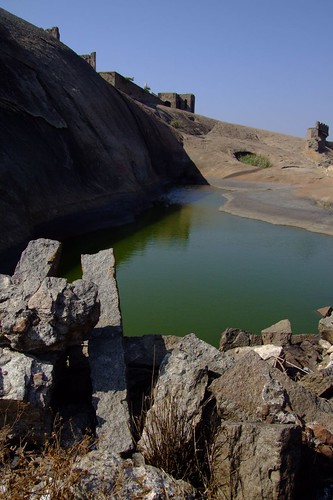
Alongside the original structure, artefacts of later ages, primarily stucco ruins and the odd rock inscription silently overlook over the rocky landscape. The strategic importance of the stone fort was reduced with the advent of cannons in the 15th Century, by which time the fort was controlled by the Brahmani sultans. As time passed, the fort was converted into a prison under the reign of sultan Qutab Shahi. The fort was presumably abandoned by the time of the British invasion, waking only briefly during the 1940s during the overthrow of the Nizam's state.
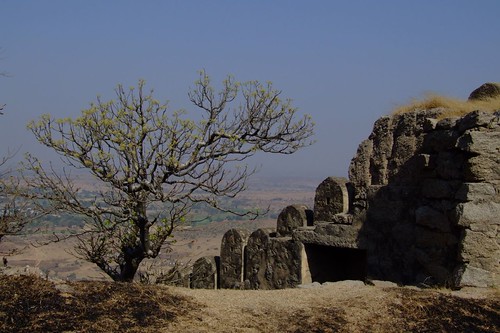
After reaching the fort, half the gang chose to climb the winding stone stairs, while the more intrepid kind attempted to scale the cobbled rock surface, all the way to the top. After a course of rock climbing, involving unbelievable jugglery with hanging cameras and other entrails, through thorny bushes and cobbled terrain, the motley bunch reached the top. The view from the top was breathtaking, to say the least, partly on acount of the climb. Beyond rusty cannon turrets lay the vast plains of Nalgonda, dotted with hillocks.
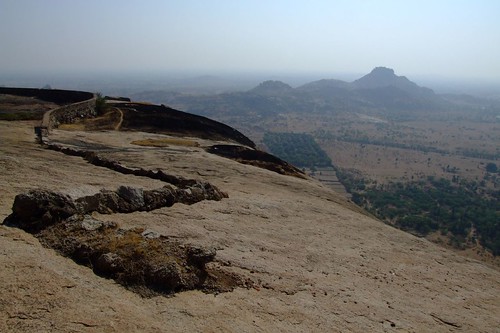
On the way down, the hipposaur claims that the stone steps which go under the ruined archways, cutting across silver-barked trees is the best path to descend. On their way down the 300 feet descent, they met a friendly family who offered the bunch the tastiest home made vadas on the planet. Needless to say, the bundle of exhausted travellers found this to be the sweetest gesture of Andhra hospitality. A photo was duly captured, to preserve this moment.

In a short while, following the steps, through winding steps, they left behind the grey-brown rocks of Bhongir- still standing tall, as the landscape below filled with the lights and fumes of the highway.
However the journey did not end here, not by a long shot.
Lunch time beckoned as the hungry bundle dropped in to one of the many lunch messes around the bus stand for a filling meal of rice, curry, sambar, pickle and the ubiquitous bowl of curds served, in the traditional way, on plates made out of dried leaves, resembling the saal [Sassafras (Sassafras albidum)] patta plates in Bengal. After a hearty meal, the travellers hopped on to a bus heading for Yadagirigutta, a town barely 14 kms away from Bhongir, to have a dekho of the famed Narasimha Temple. From the bus stop they picked up yet another autorickshaw, 5 bucks and long winding uphill ride later, they were at the temple. Now the temple looked like any old temple in south India, with its distinctly steep pyramid like shape, what interested them was the fact that the brightly coloured ornate carvings shared elements from Buddhist architecture.

A short while later they were on their way back to Bhongir to catch the evening passenger train back to Secunderabad. However a minor adventure ensued as some of the intrepid bunch quietly clambered on to the luggage carrier on top of the bus to Bhongir, so as to catch a glimpse of the highway, wind in their hair et al.

Halfway through the journey the bus driver was convinced that there were some kind of simian beasts dancing on the roof of the bus. Long story short- they were, tragically enough, forced to travel the remaining 4 kms in a manner more suited to bipeds- downstairs in the bus dibba with other passengers.
The setting sun turned a shade of rich gold as the train made an exit from the small town of Bhongir, leaving behind the imposing facade of the ruined fort, caught in eternal slumber.
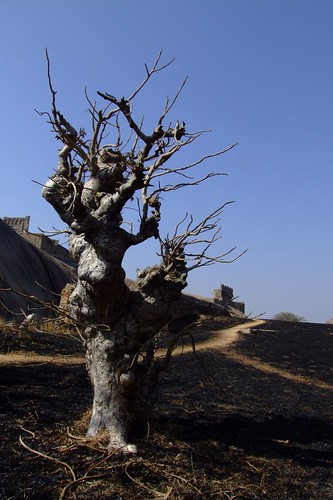
Roster:
Train Ticket to Bhongir: 33 Bucks
Autorickshaw ride to the fort: 5 Bucks
Meal at Lunch mess: 25 Bucks
Ride to Yadagirigutta: 5 Bucks
Autorickshaw to the temple: 5 Bucks
Ride back to Bhongir (with free view from the luggage carrier): 6 bucks
Passenger Train back to Secunderabad (grabbing seats by pushing and shoving): 10 Bucks
Nice!

No comments:
Post a Comment